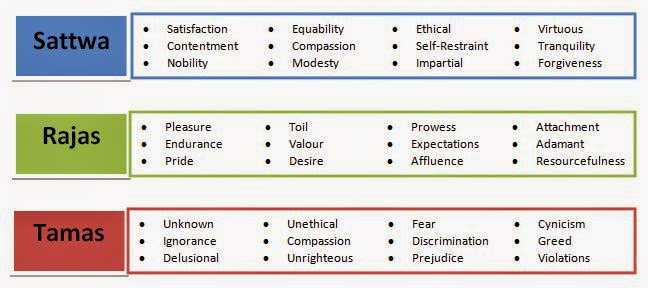Corporate Gunas from Bhagavad
Gita – Revelations
Bhagavad Gita talks about 3 Gunas
(characteristics) that are available in varying proportions in almost every
individual. It’s very interesting that
all this characteristics are somehow interrelated and have impact on the
overall stature and disposition of an individual. These 3 Gunas are Sattwa, Rajas and Tamas.
Let us firstly understand what we
are talking about here, What does each Guna broadly means :
- Sattwa refers to Nirvana, lack of desire due to content and fulfillment
- Rajas refers to passion , Energy and activeness
- Tamas refers to Inertia and negativity
I have tried listing down some of
the characteristic traits of the particular Gunas below:
 |
| The 3 Gunas |
Now that we have a basic idea
about the various Gunas, Let’s talk about its analogy and usage in the context
of the management and corporate world. I have tried capturing the causes, effects and personality types across the various Gunas in the table given below:
 |
| Gunas - Causes & Effects |
Everything said and done every
individual has a mix of all the three qualities and their impacts are interrelated
and a person can change his characteristics on basis of situations and time. It’s
an interesting topic in itself to
discuss these impacts but for now will just say that what matters is how
controlled is that individual in utilizing and leveraging those Gunas for his
benefit in best possible manner and which Guna is more prominent in that
individual. I have tried depicting that in the simple diagram below:
 |
| The Guna Wheels |
Also
Guna is a characteristic and state of mind and sometimes few attributes of
other Gunas in right context are usually helpful. For example it’s good to have
a Rajasi quality of being aggressive (controlled and channelized aggression) in
your approach sometimes in an extremely competitive market but as I said this
is only a short term approach though many times organizations need this quick
fix. Also sometimes it helps to have a Tamasi
quality of being doubtful, it helps in being cautious and reducing risks. I
will leave you with this thought. This is
just a brief capture of a huge topic and lot of context needs to be built before
we get into further details, and actually discuss cases and situations and
study the impact of this technique and how can we use it effectively to reach
the ultimate state of a progressive and sustainable environment for any organization or at an individual level.
Disclaimer: This article was accomplished by author (Aniket Samant) in his personal capacity. The views expressed in this article are the author's own and do not reflect the view of any organization or body he is/was associated with.
Comments
Post a Comment